- Cosmetic Dentistry
- Tooth Whitening
- Cosmetic Veneers
- Dental Bridges
- Same Day Emergency Treatment
- Regular Check Ups
- Oral Cancer Screening
- Oral Hygiene
- Sports Mouthguards
- Children's Dental Treatments
- Early, Late and Saturday Appointments
- Periodontal Treatment
- Night Guards
- Referral Service
- Nervous Patient Programme
- Oral Health Education
- Preventative Care
- Fissure Sealants
- Denplan

Teeth are stained by the foods and drinks we consume. Smoking further stains teeth and the natural bright, white shade becomes darkened. Teeth whitening is a successful and simple method of lightening the colour of your teeth.
The degree of whiteness achieved will vary from patient to patient and with the type of bleaching process chosen. Home Whitening involves a whitening gel being placed in a custom-made tray which you can wear whilst asleep or for short periods during the day. Results are normally seen over 2 weeks.
If your front teeth are stained, chipped, or malaligned, veneers will give you a good life-like cosmetic appearance with minimum tooth adjustment.
A veneer is a porcelain facing on the front of your teeth usually your top teeth. It is just like a false finger nail.
Veneers are made out of porcelain and are used mainly for aesthetic reasons.
Veneers make teeth look natural and healthy. They are very thin and are held in place by a special strong bond (rather like super-glue) so very little preparation of the tooth is needed.
Porcelain veneers can improve the colour, shape and position of teeth.
A precise shade of porcelain can be chosen to give the right colour to improve a single discoloured or stained tooth or to generally lighten front teeth (usually the upper ones).
Veneers can also be used to close small gaps when orthodontics (braces) are not suitable.
If one tooth is slightly out of position a veneer can sometimes be fitted to bring it into line with the others.
Visit Central Dental near Twickenham to find out more about veneer cosmetic dentistry from our expert, Dr Hothi.
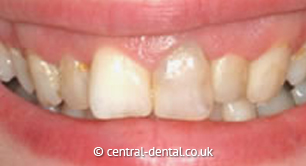
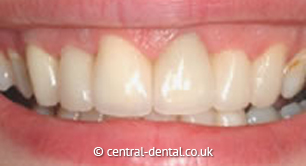
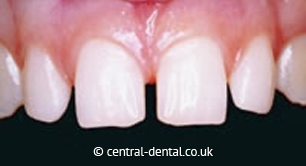
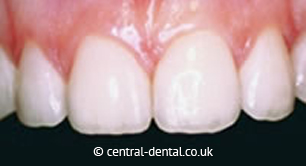
If the decay is not too serious, our cosmetic dentist will remove all the decay and restore the tooth with a white (tooth coloured) filling.
Our dentist can safely replace silver amalgam fillings with white tooth coloured fillings.
Dental decay happens when the enamel and dentine of a tooth become softened by acid attack, producing a cavity (hole).
Find out more about decay detection in our Preventative Dentistry section.
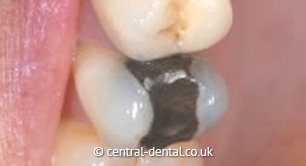
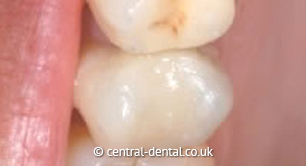
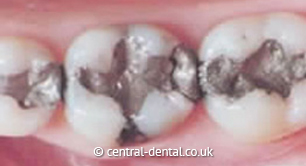
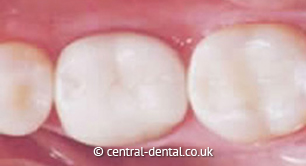
Aesthetic recontouring of your teeth involves small, minimal adjustment of your teeth to reshape and level your smile. By altering the way your teeth reflect the light we can help to camouflage twisted or misshapen teeth without more invasive procedures.
Your gums frame and drape your teeth. Like a beautiful picture in the wrong frame, if the levels and shape of your gums aren't right, your smile may not look right. By altering the shapes of your gums, we can lengthen your teeth and improve your confidence in your smile.
Lengthen the appearance of your teeth by reshaping your gums.
Shorten, smoothen or level your teeth to improve your smile line.
Sometimes there may not be room in your mouth for your wisdom teeth and as they start to come through, they push against the teeth already there or may start to come through at an angle. When this happens, you might feel some pain or discomfort, so the best thing to do is to visit your dentist.
The dentist will probably take an x-ray of your mouth to see how - or if - your wisdom teeth are coming through. From this, they will be able to make a judgement on whether or not to take them out, and how easy or difficult it might be. Extractions can also be done under sedation.
Having a tooth out is the same as having an operation and, because of this, you must look after the area to speed healing and to reduce the risk of infection. Here are some pointers:
- For the first 24 hours, try to avoid eating hot food, don't smoke, don't drink any alcohol and try not to disturb any blood clot which might have formed.
- Don't rinse your mouth for 24 hours after extraction. After that, rinse gently with warm salty water - half a teaspoon of salt in a glass of water is enough.
- Brush your teeth as normal to keep your mouth as clean as possible.
- You may feel some small pieces of bone work their way out of the socket - don't worry, this is perfectly normal.
- There may be some swelling and a bit of discomfort in the first two to three days. If you need to, take some ordinary painkillers - aspirin, ibuprofen or paracetamol will be fine.
- If you feel pain a few days after the tooth has been removed, it might be where the blood clot has broken down leaving an empty hole in the gum. This is called a 'dry socket' and will need to be looked at by your dentist. Simply come back to the practice and the dentist will pack the wound to ease your discomfort.
Your dentist may have given you some gauze to place onto the area where the tooth has been removed - if not, a clean cloth handkerchief will do just as well (but not a paper tissue).
- Roll it into a small firm pad large enough to fit over the gap (probably around 1cm by 3cm).
- Sit up and gently clear away any blood clots around the gap using the gauze or hanky.
- Put a clean pad over the gap (from tongue side to cheek side) and bite down on it firmly for 10 to 15 minutes.
- Take the pad off and check whether the bleeding has stopped. If not, apply a fresh pad and contact your dentist.
Root canal treatment (also called endodontics) is needed when the blood or nerve supply of the tooth (known as the pulp) is infected through decay or injury.
If the pulp becomes infected, the infection may spread through the root canal system of the tooth.
This may eventually lead to an abscess. If root canal treatment (RCT) is not carried out, the infection will spread and the tooth may need to be taken out.
No. A local anaesthesia is used and it should feel no different to having an ordinary filling done.
The aim of the treatment is to remove all infection from the root canal. The root is then cleaned and filled to prevent any further infection. Root canal treatment is a skilled and time-consuming procedure. Most courses of treatment will involve two or more visits to your dentist.
At the first appointment, the infected pulp is removed. Any abscesses, which may be present, can also be drained at this time. The root canal is then cleaned and shaped ready for the filling. A temporary filling is put in and the tooth is left to settle.
The tooth is checked at a later visit and when all the infection has cleared, the tooth is permanently filled.
In the past, a root filled tooth would often darken after treatment. However, with modern techniques this does not usually happen. If there is any discolouration, there are several treatments available to restore the natural appearance.
Root canal treatment is usually very successful. However, if the infection comes back the treatment can be repeated.
The alternative is to have the tooth out. Once the pulp is destroyed, it can’t heal and it is not recommended to leave an infected tooth in the mouth. Although some people would prefer an extraction, it is usually best to keep as many natural teeth as possible.
Yes. However, it is better to restore the tooth with a crown to provide extra support and strength to the tooth.
Root canal treatment is a routine dental procedure, which your dentist will be happy to do for you.
Root-treated teeth should be treated just the same as any other tooth. Remember to clean your teeth at least once a day, preferably with a fluoride toothpaste. Cut down on sugary snacks, and keep them only to mealtimes if possible. See your dentist for regular check-ups.
FISSURE sealants (tooth coloured sealants) are applied to biting surfaces of children's teeth to prevent decay.
Dental hygiene treatment includes professionally cleaning the teeth for the patient. This is usually called scaling and polishing. However, perhaps our most important role is showing the patient the best way to keep the teeth free of plaque.
The dentist also plays an important role in treating gum disease.
Bad breath is a very common problem and there are many different causes. Persistent bad breath is usually caused by the smelly gases released by the bacteria that coat your teeth and gums.
However, strong foods like garlic and onions can add to the problem. Smoking is also one of the main causes of bad breath, along with certain illnesses such as nasal and stomach conditions.
Bits of food that get caught between the teeth and on the tongue will rot and can sometimes cause an unpleasant smell. So correct and regular brushing is very important to keep your breath smelling fresh.
The bacteria on our teeth and gums (plaque) also cause gum disease and dental decay. If you see your dentist regularly this will not only help prevent bad breath but will also let the dentist look for and treat these problems.
Screening for gum disease forms an integral part of your routine examination.
Gum disease describes swelling, soreness or infection of the tissues supporting the teeth. There are two main forms of gum disease: gingivitis and periodontal disease.
Gingivitis means inflammation of the gums. This is when the gums around the teeth become very red and swollen. Often the swollen gums bleed when they are brushed during cleaning.
Long-standing gingivitis can turn into periodontal disease. There are a number of types of periodontal disease and they all affect the tissues supporting the teeth. As the disease gets worse the bone anchoring the teeth in the jaw is lost, making the teeth loose. If this is not treated, the teeth may eventually fall out.
All gum diseases are caused by plaque. Plaque is a film of bacteria which forms on the surface of the teeth and gums every day. Many of the bacteria in plaque are completely harmless, but there are some that have been shown to be the main cause of gum disease. To prevent and treat gum disease, you need to make sure you remove all the plaque from your teeth every day. This is done by brushing and flossing.
Unfortunately, gum disease progresses painlessly on the whole so that you do not notice the damage it is doing. However, the bacteria are sometimes more active and this makes your gums sore. This can lead to gum abscesses, and pus may ooze from around the teeth. Over a number of years, the bone supporting the teeth can be lost. If the disease is left untreated for a long time, treatment can become more difficult.
The first sign is blood on the toothbrush or in the rinsing water when you clean your teeth. Your gums may also bleed when you are eating, leaving a bad taste in your mouth. Your breath may also become unpleasant.
Using higher magnification and powerful lighting, it is easier to detect decay at an early stage to prevent excessive tooth damage. When cavities are small, they are much easier and less expensive to treat.
Early tooth decay does not tend to show many physical signs. Sometimes the tooth looks healthy, but your dentist will be able to see from an x-ray whether you have any decay under the enamel, any possible infections in the roots, or any bone loss around the tooth.
Mouth cancer is a malignant growth which can occur in any part of the mouth, including the tongue, lips and throat. Mouth cancers have a higher proportion of deaths per number of cases than breast cancer, cervical cancer or skin melanoma. The mortality rate is just over 50%, despite treatment, with about 1,700 deaths per year in the UK. This is because of late detection. Visit your dentist at once if you notice any abnormal problems or are not sure. Regular dental checkups allow early detection of abnormalities in the mouth.

The Mouth Cancer Foundation is a registered charity that raises awareness of mouth cancers and provides information and support to patients, carers and health professionals.

It's not easy... so that's why this web site is here. Giving up smoking requires preparation, determination, and support. This site is here to help you with each of these. If you're thinking about giving up, take a look at this site.
We have access to some excellent specialist services, and we will refer you to them for Orthodontic, Implantology, Oral surgery and Periodontal care. At Central Dental we stock a wide range of oral healthcare products at competitive prices for your convenience. Please ask at reception.


